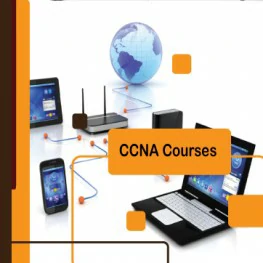CCNA is an advanced professional diploma provided by The American Academy for Training Courses (AATC) which is an ISO-9001 accredited language learning and training center, collaborating with Atlanta Institute and the American Academy is one of the largest language learning centers all over Egypt.
Cisco is a US worldwide leader in networking and providing routers and switches. Furthermore, Cisco has developed its own training programs which are well-reputable all over the world, having established its Cisco Networking Academy providing networking certificates which are accredited everywhere in the world. Certified Cisco Network Associate (CCNA) certificate validates the ability to install, configure, operate, and troubleshoot medium-size routed and switched networks
Introduces the architecture, structure, functions, components, and models of the Internet and computer networks. The principles of IP addressing and fundamentals of Ethernet concepts, media, and operations are introduced to provide a foundation for the curriculum. By the end of the course, students will be able to build simple LANs, perform basic configurations for routers and switches, and implement IP addressing schemes.
Describes the architecture, components, and operations of routers and switches in a small network. Students learn how to configure a router and a switch for basic functionality. By the end of this course, students will be able to configure and troubleshoot routers and switches and resolve common issues with RIPv1, RIPv2, single-area and multi-area OSPF, virtual LANs, and inter-VLAN routing in both IPv4 and IPv6 networks.
Describes the architecture, components, and operations of routers and switches in a large and complex network. Students learn how to configure routers and switches for advanced functionality. By the end of this course, students will be able to configure and troubleshoot routers and switches and resolve common issues with OSPF, EIGRP, STP, and VTP in both IPv4 and IPv6 networks. Students will also develop the knowledge and skills needed to implement DHCP and DNS operations in a network.
Discusses the WAN technologies and network services required by converged applications in a complex network. The course enables students to understand the selection criteria of network devices and WAN technologies to meet network requirements. Students learn how to configure and troubleshoot network devices and resolve common issues with data link protocols. Students also develop the knowledge and skills needed to implement IPSec and virtual private network (VPN) operations in a complex network
Describe the devices and services used to support communications in data networks and the Internet Describe the role of protocol layers in data networks Describe the importance of addressing and naming schemes at various layers of data networks in IPv4 and IPv6 environments Design, calculate, and apply subnet masks and addresses to fulfill given requirements in IPv4 and IPv6 network Build a simple Ethernet network using routers and switches Use Cisco command-line interface (CLI) commands to perform basic router and switch configurations
Describe enhanced switching technologies such as VLANs, VLAN Trunking Protocol, Rapid Spanning Tree Protocol, and 802.1q Describe basic switching concepts and the operation of Cisco switches Configure and troubleshoot basic operations of a small switched network Configure and troubleshoot basic operations of routers in a small routed network Configure and troubleshoot VLANs and inter-VLAN routing Describe the operations of Dynamic Host Configuration Protocol and Domain Name System for IPv4 and IPv6
Configure and troubleshoot DHCP and DNS operations for IPv4 and IPv6 Describe the operations and benefits of the Spanning Tree Protocol (STP) Configure and troubleshoot STP operations Describe the operations and benefits of link aggregation and Cisco VLAN Trunk Protocol (VTP) Configure and troubleshoot basic operations of routers in a complex routed network for IPv4 and IPv6 Configure and troubleshoot advanced operations of routers and implement RIP, OSPF, and EIGRP routing protocols for IPv4 and IPv6 Manage Cisco IOS® Software licensing and configuration files
Describe the operations and benefits of virtual private networks (VPNs) and tunneling describe different WAN technologies and their benefits Configure and troubleshoot serial connections Configure and troubleshoot broadband connections Configure and troubleshoot IPSec tunneling operations Monitor and troubleshoot network operations using syslog, SNMP, and NetFlow Design network architectures for borderless networks, data centers, and collaboration
